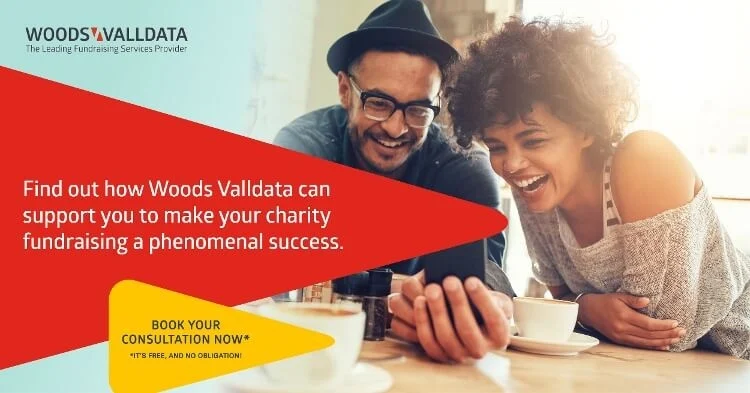
Beyond Face-to-Face: The Future of Acquiring New Donors
Let's talk fundraising - and more specifically, the changing world of acquiring new donors.
If you're feeling the pinch in recruiting new donors, you're not alone. Recent research paints a challenging picture.
The Open Charity Benchmarks shows that in 2024, charities are seeing fewer new supporters compared to 2023, with an average recruitment drop of 8.6%. But here's the good news: this isn't a dead-end, it's an opportunity to reimagine how we connect with potential supporters.
For years, face-to-face fundraising and direct mail have been our trusty workhorses. They've served the sector well, but the landscape is shifting. The Woods Valldata webinar, Beyond F2F, with expert insights from leading voices across the sector revealed some fascinating insights that might just change how you think about acquisition. Our panel included:
- James Briggs from Open
- Alf Cowan from Medialab
- Namita Harvey from Guy’s & St Thomas’ Charities
- Andrew Sargent from Sequoia Insights
The key take-outs
- Over 80% of charities surveyed during the webinar (94 responders) are using face-to-face and paid social media ads when acquiring new donors
- 61% of charities surveyed during the webinar said social media presented the biggest future opportunities to acquire new donors
- Digital channels are no longer just an experiment – they're essential
- Different channels attract different supporter demographics
What's working right now?
Social media isn't just for cat videos and holiday snaps. Paid social ads are becoming a powerhouse for recruitment. They offer flexibility, precise targeting, and the ability to tell your charity's story in creative ways.
But here's the catch – it's not about jumping on every digital bandwagon. It's about understanding your audience and speaking their language.
For example, Andrew Sargent highlighted how different acquisition channels attract remarkably different demographic groups. A face-to-face campaign might predominantly recruit younger supporters – with just 10% being retired – while something like newspaper inserts could attract a much older audience, with nearly 40% in the retired bracket.
Consider, too, the nuanced approach of Guy's and St Thomas's Charity. Namita Harvey shared how they've been strategic about their lead generation, creating targeted content like the Evelina Play Guide. This isn't just a generic leaflet, but a carefully crafted resource designed to resonate with people genuinely interested in their cause.

Alf Cowan made a brilliant point about the importance of understanding what actually works on the ground. He shared an example where changing language from "regular givers" to "members" in advertising for the RNLI led to a significant performance uplift. It's these granular insights – learned from real conversations with supporters – that can transform an acquisition strategy.
The lesson? Understanding supporter motivations, and crafting messages that genuinely speak to people's values and interests are essential when acquiring new supporters.
Emerging Opportunities
James Briggs introduced some exciting developments that are changing the game:
- WhatsApp engagement
- SMS communication strategies
- Targeted digital content
- New regulatory changes making multi-channel communication easier
The Data Use and Access Bill is a game-changer. Charities can now re-contact supporters via email and text more freely, opening up new pathways for personalised engagement.
A Word of Caution
Different channels attract different people. What works for a younger audience on Instagram might not resonate with an older demographic receiving a direct mail piece. The key is understanding these nuances and tailoring your approach.
Practical Steps Forward
1. Diversify your acquisition channels
2. Invest in understanding your audience
3. Experiment with digital lead generation
4. Personalise your communication
5. Stay flexible and ready to adapt
6. make follow-on communication personalised and fast

The Retention Imperative
This isn't about replacing face-to-face fundraising. It's about complementing it.
Think of new acquisition approaches as additional tools in your fundraising toolkit, not replacements for personal connection. We're seeing charities like Guy's and St Thomas's Hospital successfully blend traditional and innovative approaches. They're proving that innovation doesn't mean abandoning what works – it means building on it.
Your Next Move
Take a critical look at your current acquisition strategy. Where are the gaps? What channels aren't you exploring? Sometimes, the smallest tweak can make the biggest difference.
We're All in This Together
The fundraising sector has always been resilient, adaptive, and mission-driven. By staying curious, embracing new technologies, and keeping supporters at the heart of our strategies, we can continue making a transformative difference.
Working with partners you can rely on makes all the difference. Woods Valldata are experts in response handling and fulfilment, so regardless of the channel you acquire your new supporters, we’re here to help you ensure that their first experience of your charity is second to none.
Want to explore these ideas further? We’re your Partners in Possibility. Our team at Woods Valldata is always ready to chat, share insights, and help you develop and implement sustainable, supporter-centric fundraising programmes.
Categories
- charity fundraising (50)
- Lottery (40)
- Income Generation for Charities (38)
- Raffle (37)
- Appeal response handling (31)
- Response Handling (27)
- fundraising insights (23)
- charity gaming (19)
- charity raffle (17)
- Fulfilment (16)
- charity insights (16)
- Compliance (12)
- Company News (11)
- benchmarks (10)
- Direct Debit (9)
- Services (8)
- creating a fundraising strategy (8)
- Gambling Act (5)
Archives
- March 2020 (5)
- May 2022 (4)
- October 2022 (4)
- January 2023 (4)
- June 2023 (4)
- May 2024 (4)
- June 2024 (4)
- March 2021 (3)
- April 2021 (3)
- July 2023 (3)
- August 2023 (3)
- April 2024 (3)
- July 2024 (3)
- November 2025 (3)
- June 2020 (2)
- August 2020 (2)
- October 2020 (2)
- November 2020 (2)
- November 2021 (2)
- January 2022 (2)
- February 2022 (2)
- February 2023 (2)
- March 2023 (2)
- September 2023 (2)
- December 2023 (2)
- February 2024 (2)
- March 2024 (2)
- February 2025 (2)
- July 2025 (2)
- December 2025 (2)
- June 2015 (1)
- November 2017 (1)
- February 2020 (1)
- April 2020 (1)
- May 2020 (1)
- July 2020 (1)
- September 2020 (1)
- May 2021 (1)
- June 2021 (1)
- August 2021 (1)
- September 2021 (1)
- October 2021 (1)
- December 2021 (1)
- March 2022 (1)
- April 2022 (1)
- June 2022 (1)
- July 2022 (1)
- August 2022 (1)
- September 2022 (1)
- December 2022 (1)
- May 2023 (1)
- October 2023 (1)
- November 2023 (1)
- January 2024 (1)
- September 2024 (1)
- January 2025 (1)
- March 2025 (1)
- September 2025 (1)
- October 2025 (1)
